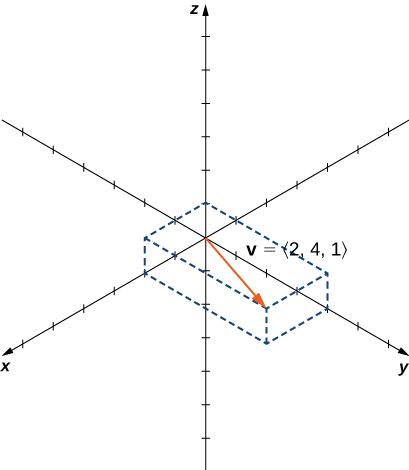Learning Objectives
- Perform vector operations in [latex]\mathbb{R}^3[/latex].
Just like two-dimensional vectors, three-dimensional vectors are quantities with both magnitude and direction, and they are represented by directed line segments (arrows). With a three-dimensional vector, we use a three-dimensional arrow.

Figure 1. Vector [latex]v=⟨2,4,1⟩[/latex] is represented by a directed line segment from point [latex](0,0,0)[/latex] to point [latex](2,4,1)[/latex].
Vector addition and scalar multiplication are defined analogously to the two-dimensional case. If [latex]\mathbf{v} = \langle x_1,y_1,z_1 \rangle[/latex] and [latex]\mathbf{w} = \langle x_2,y_2,z_2 \rangle[/latex] are vectors, and [latex]k[/latex] is a scalar, then
If [latex]k=-1[/latex], then [latex]k\mathbf{v} = (-1)\mathbf{v} [/latex] is written as [latex]-\mathbf{v} [/latex], and vector subtraction is defined by [latex]\mathbf{v-w} = \mathbf{v+ (-w)} = \mathbf{v} + (-1)\mathbf{w} [/latex].
The standard unit vectors extend easily into three dimensions as well—[latex]\mathbf{i} = \langle 1,0,0 \rangle[/latex], [latex]\mathbf{j} = \langle 0,1,0 \rangle[/latex], and [latex]\mathbf{k} = \langle 0,0,1 \rangle[/latex]—and we use them in the same way we used the standard unit vectors in two dimensions. Thus, we can represent a vector in [latex]\mathbb{R}^3[/latex] in the following ways:
Example: vector representations
Let [latex]\overrightarrow{PQ}[/latex] be the vector with initial point [latex]P=(3, 12, 6)[/latex] and terminal point [latex]Q=(-4, -3, 2)[/latex] as shown in Figure 2. Express [latex]\overrightarrow{PQ}[/latex] in both component form and using standard unit vectors.

Figure 2. The vector with initial point [latex]P=(3,12,6)[/latex] and terminal point [latex]Q=(−4,−3,2)[/latex].
try it
Let [latex]S=(3, 8, 2)[/latex] and [latex]T=(2, -1, 3)[/latex]. Express [latex]\overrightarrow{ST}[/latex] in component form and in standard unit form.
As described earlier, vectors in three dimensions behave in the same way as vectors in a plane. The geometric interpretation of vector addition, for example, is the same in both two- and three-dimensional space (Figure 3).

Figure 3. To add vectors in three dimensions, we follow the same procedures we learned for two dimensions.
We have already seen how some of the algebraic properties of vectors, such as vector addition and scalar multiplication, can be extended to three dimensions. Other properties can be extended in similar fashion. They are summarized here for our reference.
rule: properties of vectors in space
Let [latex]\mathbf{v} = \langle x_1,y_1,z_1 \rangle[/latex] and [latex]\mathbf{w} = \langle x_2,y_2,z_2 \rangle[/latex] be vectors, and let [latex]k[/latex] be a scalar.
Scalar multiplication: [latex]k\mathbf{v} = \langle kx_1,ky_1,kz_1 \rangle[/latex]
Vector addition: [latex]\mathbf{v+ w} = \langle x_1,y_1,z_1 \rangle + \langle x_2,y_2,z_2 \rangle = \langle x_1 +x_2,y_1 +y_2,z_1 +z_2 \rangle[/latex]
Vector subtraction: [latex]\mathbf{v- w} = \langle x_1,y_1,z_1 \rangle - \langle x_2,y_2,z_2 \rangle = \langle x_1 -x_2,y_1 -y_2,z_1 -z_2 \rangle[/latex]
Vector magnitude: [latex]\|\mathbf{v}\| = \sqrt{x_1^2 + y_1 ^2 + z_1 ^2}[/latex]
Unit vector in the direction of v: [latex]\frac{1}{\|\mathbf{v}\|}\mathbf{v} = \frac{1}{\|\mathbf{v}\|} \langle x_1,y_1,z_1 \rangle = \langle \frac{x_1}{\|\mathbf{v}\|}\frac{y_1}{\|\mathbf{v}\|}\frac{z_1}{\|\mathbf{v}\|} \rangle[/latex] if [latex]\mathbf{v} \neq \mathbf{0}[/latex].
We have seen that vector addition in two dimensions satisfies the commutative, associative, and additive inverse properties. These properties of vector operations are valid for three-dimensional vectors as well. Scalar multiplication of vectors satisfies the distributive property, and the zero vector acts as an additive identity. The proofs to verify these properties in three dimensions are straightforward extensions of the proofs in two dimensions.
Example: vector operations in three dimensions
Let [latex]\mathbf{v} = \langle -2,9,5 \rangle[/latex] and [latex]\mathbf{w} = \langle 1,-1,0 \rangle[/latex] (Figure 4). Find the following vectors.
- [latex]3\mathbf{v} -2\mathbf{w}[/latex]
- [latex]5\|\mathbf{w}\|[/latex]
- [latex]\|5\mathbf{w}\|[/latex]
- A unit vector in the direction of [latex]\textbf v[/latex]

Figure 4. The vectors [latex]{\bf{v}}=⟨−2,9,5⟩[/latex] and [latex]{\bf{w}}=⟨1,−1,0⟩[/latex].
try it
Let [latex]\mathbf{v} = \langle -1,-1,1 \rangle[/latex] and [latex]\mathbf{w} = \langle 2,0,1 \rangle[/latex]. Find a unit vector in the direction of [latex]5\mathbf{v}+3\mathbf{w}[/latex].
Watch the following video to see the worked solution to the above Try IT.
Try It
Example: throwing a forward pass
A quarterback is standing on the football field preparing to throw a pass. His receiver is standing 20 yd down the field and 15 yd to the quarterback’s left. The quarterback throws the ball at a velocity of 60 mph toward the receiver at an upward angle of [latex]30^\circ[/latex] (see the following figure). Write the initial velocity vector of the ball, [latex]\textbf v[/latex], in component form.

Figure 5. The receiver is standing [latex]20[/latex] yd down the field and [latex]15[/latex] yd to the quarterback’s left. The quarterback throws the ball at a velocity of [latex]60[/latex] mph toward the receiver at an upward angle of [latex]30°[/latex]
try it
Assume the quarterback and the receiver are in the same place as in the previous example. This time, however, the quarterback throws the ball at velocity of 40 mph and an angle of [latex]45^\circ[/latex]. Write the initial velocity vector of the ball, [latex]\textbf v[/latex], in component form.

